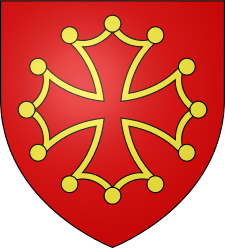Bernard Plantapilosa
Bernard Plantapilosa (22 March 841 – 886[1]), or Plantevelue, son of Bernard of Septimania and Dhuoda, was the Count of Auvergne (as Bernard II) from 872 to his death. The Emperor Charles the Fat granted him the title of Margrave of Aquitaine in 885.
His mother's Liber Manualis mentions that he was born at Uzès in the year following the death of Louis the Pious. He was appointed Margrave of Septimania (or Gothia) before 868. He was the lay abbot of Brioude between 857 and 868 and Count of Autun and from 864 to 869. He was deposed before 876 and replaced by Bernard of Gothia in that year. He returned to favour under Charles the Fat. In the war against Boso of Provence, he obtained the county of Mâcon.
Family
He married Ermengard, daughter of Bernard I of Auvergne (or perhaps of Guerin I). They had at least two children:
- William I of Aquitaine
- Adelinda, who married Acfred I of Carcassonne
Etymology
Plantapilosa is often claimed to mean "Hairyfeet" or "Hairypaws".[2] This is based on the Latin meaning "sole of foot" of planta. However, in Basque, which is a descendant of the Aquitanian language, planta means "appearance" yielding the meaning "hairy appearance". Also, planta has another Latin meaning, "shoot for propagation". This yields the meaning "Hairyshoot" which, since the broom shoot is hairy, can be compared with the "sprig of broom" symbolism of the subsequent, nearby Plantagenet name.[3] In Old Aquitanian, gods' names were cognate with Basque words for animals and plants.
Notes
- ↑ Also possibly 6 January or 16 August 886
- ↑ E.g. Chris Wickham, The Inheritance of Rome, p. 511
- ↑ Dr. John S Plant (2007), "The Tardy Adoption of the Plantagenet Surname", Nomina, esp. Appendix A: An opinion concerning the name Planta-pilosa.
Sources
- MacLean, Simon. Kingship and Politics in the Late Ninth Century: Charles the Fat and the end of the Carolingian Empire. Cambridge University Press: 2003.
- Hummer, Hans J. Politics and Power in Early Medieval Europe: Alsace and the Frankish Realm 600 – 1000. Cambridge University Press: 2005.
|
| |||||||||||||
